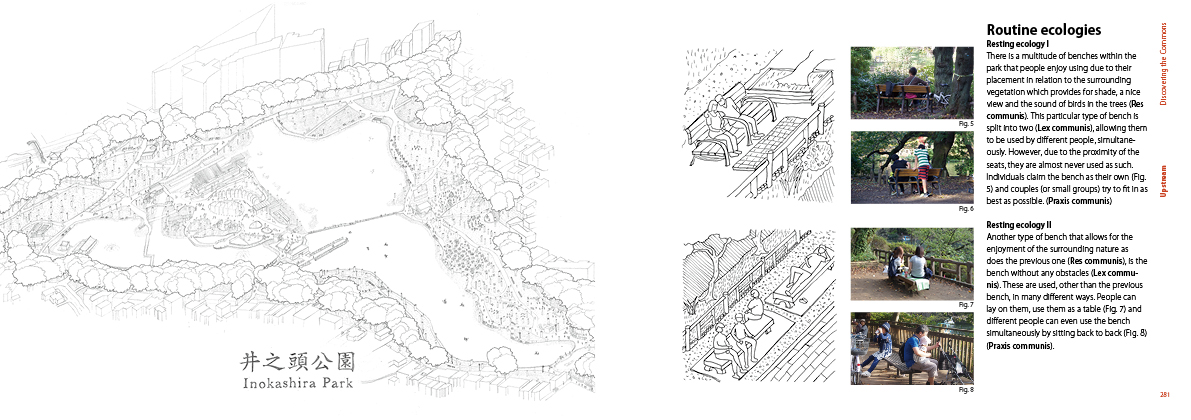The evolution of the different communis of an ecology typically starts with the available resources, the ʻRes communisʼ. In Inokashira Park, these resources can be considered as the basic foundations of the park. The trees and their shade, the water and its reflection, the birds and their singing – all make up this most primal layer of what can be considered the ʻInokashira Park ecologyʼ. The area of Inokashira Park was formerly restricted to be used solely by the Imperial family. This practice, or ʻPraxis communisʼ, was thus very limited and can even be considered to have been completely restrictive. Only until after the area had been donated to the people and was opened as a park in 1917 were the resources unlocked to the public. But, merely opening a park does not truly make it accessible to the public. Certain facilities, or ʻLex communisʼ, were constructed to allow for the visitors of the park to actually enjoy and experience the Res communis Inokashira Park had to offer. These newly built paths, benched, fences and more, had changed the Praxis communis of the landscape into something that could be practiced by all people visiting. Over time, however, more and more Lex communis was added to the park. Bridges, a variety of benches, many toilets, different paths, restaurants and even a paid zoo and swan-shaped pedalos became a part of the Inokashira Park ecology. Most of these additions did not deal with presenting the resources of the park to its users, however – they simply allowed for the accommodation of many more visitors. Those that did, however, required a fee to access these resources. This is how we encountered Inokashira Park – a theme park for the masses. Having observed the different layers of the three communis of Inokashira Park, simultaneously, we got to understand the way these communis interacted and how much they were dependent on each other. We learned how the practiced Praxis communis was lacking order because of the built Lex communis and, in turn, how the built Lex communis interfered with making the available Res communis accessible to the people. This meant that the Lex communis could be considered the crux within Inokashira Park. Their placements, practicalities and appearances lack consideration regarding its surroundings and usage. By understanding the issues at hand and by analysing its causes, we were able to pinpoint which interventions would have to be made to improve the functionality of the multi-layered ecology of Inokashira Park. Firstly, the built structure of the park is to be clarified and simplified by means of subtraction and adjustment. Certain paths will be removed or redirected; its surface materials changed and their facilities adjusted, so that a smoother flow of the different Praxis communis that are practiced within the park can be realised. As such, these different Praxis communis will be less likely to interfere with each other, without limiting their potential expressions. Secondly, by subtracting certain parts of the park structure, opportunities open up for the placements of new kind of Lex communis. These ʻpocketsʼ will be realised to provide for a better way of experiencing the resources of the park, so that the Praxis communis can truly grasp the Res communis of Inokashira Park.
